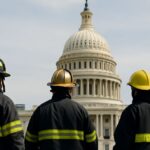No matter your political leanings, the funding included in the American Rescue Plan Act for fire and EMS was long overdue a year into the pandemic. Already facing shortages in funding, resources, and staffing, local departments were hit even harder as COVID-19 overwhelmed our nation. On top of already stretched-thin budgets, the firefighting and EMS community also began facing even more dangers given the short supply of personal protective equipment (PPE). Despite the challenges, they continued to respond to calls without proper staffing or safety gear available.
Cut to present day: a year after the first confirmed case of COVID-19. Firefighters and EMS personnel have continued to work miracles, responding to calls as they face burnout, coronavirus contractions, watched patients, friends, and family alike lose their lives to the virus and suffered from a host of mental health problems that come with working the front lines of a pandemic. All of that on top of responding to everyday calls.
And how has our government supported these frontline heroes this past year? While they have received some help from the federal government in the first two stimulus bills, this newest piece of legislation far surpasses the funding and resources allotted to Fire and EMS thus far.
According to the International Association of Fire Fighters, the American Rescue Plan Act that was signed by President Biden this past Thursday contains more than $380 million in funding for fire and EMS related expenses, including $200 million in supplemental funding for “Staffing for Adequate Fire and Emergency Response” (SAFER) grants to retain and rehire firefighters, $100 million in supplemental funding for the “Assistance to Firefighters” grant program, and $80 million to state and local governments to address suicide, burnout and behavioral health for public safety officers and healthcare professionals.
This funding, and the explicit funds earmarked for staffing and retention, mental health, and to address burnout, is the first step in the right direction for taking care of our frontline workers. Even after the pandemic is over, fire and EMS personnel will be dealing with physical and mental health repercussions. Taking these issues seriously and taking steps to address and prevent them in the future has been a needed step for years now.
The COVID-19 pandemic exacerbated issues that already existed and were pervasive for firefighters and EMS personnel. Frontline workers already deserved all of these protections and more, but it took a global pandemic and national emergency to really shine a light on these deep-seeded issues. Years, decades even, of budget cuts and shortfalls, dilapidated stations and engines, and outdated resources has quietly taken its toll on firefighters and other emergency workers.
All Americans should have hope that these funding initiatives will continue long after the pandemic is over, and our heroes can have the support they need to do their jobs safely and effectively. Let’s use this as a jumping off point, and encourage our elected officials at local, state, and federal levels to continue to stay committed to our first responders.
As we are all aware, public safety is paid for by a portion of the taxes and fees we pay each year. Notwithstanding, in far too many towns the size of fire and EMS budgets are simply not sufficient to meet the needs of a modern-day fire department.









